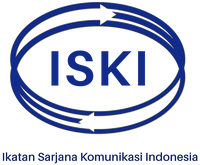Menginisiasi Nation Branding Indonesia Menuju Daya Saing Bangsa
DOI:
https://doi.org/10.31315/jik.v11i1.305Keywords:
Citra Bangsa, Daya Saing Bangsa, Integrasi, Inisiasi, KomprehensifAbstract
Nation branding memiliki potensi untuk meningkatkan daya saing nasional. Sebagai bentuk representasi diri negara yang strategis, nation branding diharapkan dapat menciptakan reputasi kapital melalui promosi kepentingan ekonomi, politik dan sosial. Pengukuran dari nation branding telah dilakukan oleh anhold-gfk roper dengan menggunakan 6 dimensi yakni: eksport, investasi dan imigrasi, pemerintah, budaya, pariwisata, dan masyarakat. Namin, 6 dimensi dari nation branding dapat ditimbang tidak cukup untuk memperkuat daya saing bangsa. Oleh karena itu, penelitian ini mengeksplorasi dan mendiskusikan dimensi di luar 6 dimensi anholt gfk roper. Dengan menggunakan pendekatan kuantitatif dan kualitatif, studi ini menemukan bahwa terdapat 17 dimensi dari nation branding sebagai perluasan dari 6 dimensi milik anholt-gfk. Penelitian ini menunjukan inisiasi dari nation branding indonesia bisa dilakukan secara parsial. Integrasi, keberlangsungan, dan sinergi diperlukan untuk mengembangkan dimensi nation branding secara komprehensif sebagai landasan untuk membangun daya saing nasional.References
American Marketing Association. Committee on Definitions.(1960). Marketing definitions; a glossary of marketing terms. Chicago: American Marketing Association.
Anderson, B. (1991). Imagined communities: Reflections on the origin and spread of nationalism (2 ed.). London: Verso
Anholt, S. (2002). Nation Branding: A continuing theme. Journal of Brand Management, 10(1), 59.
Anholt, S. (2013). Nation Brand Index, diakses 30 Oktober dari http:// www.simonanholt.com/Research/ research-introduction.aspx.
Bambang. (2007, June 4). Indonesia Siapkan “Branding” Nasional. Dipetik January 16, 2013, dari Antara News. com: http://www.antaranews.com/ view/?i=1180954610&c=NAS&s=
Bloom Consulting Enterprenuers. (2011). Country Brand Ranking. Madrid. Brand Finance. (2011). The Brand Finance® Nation Brands 100. London, United Kingdom.
Braun V, Clarke V (2006) Using thematic analysis in psychology. Qualitative Research in Psychology 3: 77 – 101.
Brymer, C. (2003). Branding a country [Electronic Version], 1-4. Retrieved January 23, 2007 from http://www.brandchannel.com/ images/papers/Country_Branding.pdf.
Burhani, R. (2009, June 25). Indonesia Tempati Urutan ke-43 Nation Brand Index. Dipetik January 16, 2013, dari Antara News.com: http://www.antaranews.com/ view/?i=1245943534&c=EKB&s=BIS
Costa, P.T. & McCrae, R. (1990) Personality disorders and the five-factor model of personality.Journal of Personality Disorders, 4, 362 -371.
Creswell, J. W., Plano Clark, V. L., Gutmann, M. L., &Hanson,W. E. (2003). Advanced mixed methods research designs. InA.Tashakkori&C.Teddlie (Eds.), Handbook of mixed methodsin social and behavioral research (pp. 209–240). Thousand Oaks, CA: Sage.
Diakses dari http://file.upi.edu/Direktori/FPTK/ JUR._PEND._KESEJAHTERAAN_ KELUARGA/SUNARSIH/ KOMUNIK__KELUARGA.pdf, p. 4 Dinnie, K., Melewar, T.C., Seidenfuss, K., Musa, G. (2010) Nation branding and integrated marketing communications: an ASEAN perspective, International Marketing Review, Vol. 27 Iss: 4, pp.388 – 403.
Dinnie, Keith; T.C. Melewar, Kai-Uwe Seidenfuss and Ghazali Musa. (2010). Nation Branding and Integrated Marketing Communications: an ASEAN perspective.
Dong-Hun, Lee. (2010). Nation Branding Korea. April. Fan, Y. (2006). Branding the nation : what is being branded? Journal of Vacation Marketing , 5-14.
Future Brand. (2012). Country Brand Index 2012-13. London, New York, Shanghai. GfK Nation Research North America. (2011). The Anholt-GfK Roper Nation Brands Index.
GfK Roper Public Affairs & Corporate Communications. (2010, October). The Anholt-GfK Roper Nation Brands IndexSM 2010 Report. New York, New York, United States of America.
Gfk Roper Public Affairs and Media. (2009). The Anholt-GfK Roper Nation Brands Index 2009 Highlights Report : October 2009. New York: Gfk Roper Public Affairs and Media.
Gfk Roper Public Affairs and Media. (2009). The Anholt-GfK Roper Nation Brands Index 2009 Highlights Report : October 2009. New York: Gfk Roper Public Affairs and Media.
Gfk Roper Public Affairs and Media. (2009). The Anholt-GfK Roper Nation Brands Index 2009 Highlights Report : October 2009. New York: Gfk Roper Public Affairs and Media.
Gordon, Theodore J. (1994). The Milenium Project -The Delphi Method. Diakses dari: www. gerenciamento.ufba.br/Downloads/ delphi%20(1).pdf,tanggal 13 Maret 2013.
Gosling, S. D., Rentfrow, P. J., & Swann, W. B. J. (2003).A very brief measure of the Big-Five personality domains. Journal of Research in Personality, 37(6), 504-528.
Hapsari, Tia. (2009). Rektor UI: Bom Tak Pengaruhi Jumlah Mahasiswa Asing. http://www.tempo.co/read/ news/2009/07/27/079189243/ Rektor-UI-Bom-Tak-PengaruhiJumlah-Mahasiswa-Asing.
Harrison, S. (2002). Culture, tourism and local community--the heritage identity of the Isle of Man. Journal of Brand Management , 4/5, 355.
Hasan, R. (2007, September 5). Pemimpin Tak Konsisten, Country Branding Indonesia Lemah. Dipetik January 16, 2013, dari Tempo.co: http://www.tempo.co/ read/news/2007/09/05/056106930/ Pemimpin-Tak-Konsisten-CountryBranding-Indonesia-Lemah
Hasan, Rofiqi. (2007). Indonesia’s Country Branding Weak due to Inconsistent Leaders. http://www.tempo.co.id/hg/ nasional/2007/09/05/brk,20070905- 106960,uk.html, diakses 24 April 2013.
Huh, J. (2002). Tourist Satisfaction With Cultural / Heritage Sites: The Virginia Historic Triangle. Virginia: Virginia Polythecnic Institute. Istman, MP. “Ekonomi Indonesia Tumbuh, Kelas Menengah Bahagia”. http://www.tempo.co/read/ news/2012/08/13/090423273/EkonomiIndonesia-Tumbuh-Kelas-MenengahBahagia. diakses pada 5 Februari 2012.
Kasali, R. (2012, September 13). Merosotnya Daya Saing. Dipetik January 16, 2013, dari Harian Seputar Indonesia: http://www.seputar-indonesia.com/ edisicetak/content/view/526191/38/
Klein, J. G. (2002). Us versus them, or us versus everyone?Delineating consumer aversion to foreign goods. Journal of International Business Studies, 33(2), 345-363.
Kleppe, I., Iversen, N., & Stensaker, I. (2002). Country image in marketing strategies: conceptual issues and an empirical Asian illustration. Journal of Brand Management , 61-74.
Kotler, P., &Gertner, D. (2002). Country as brand, product, and beyond: a place marketing and brand management perspective. Journal of Brand Management, 9, 4/5, 249-261. http://dx.doi. org/10.1057/palgrave.bm.2540076.
Krejcie, Robert V. dan Daryle W. Morgan. 1970. “Determining Sample Size forResearch Activities”, Educational and Psychological Measurement. Vol. 30: 607-610.
Lien, Kim, (2010). Tourist motivation and activities: A case study of Nha Trang, Vietnam. Liliweri, Alo. (1997). Komunikasi Antarpribadi. Bandung : PT.Citra Aditya Bakti.
Lindstrom, M. (2006). Country branding needs to go beyond its borders. Media Asia, 21-21 Maheshwari, V., Vandewalle, I., & Bamber, a. D. (2011). Place branding’s rolein sustainable development. Journal of Place Management and Development, 198.
Marundu, E.E., Amanze, D.N., Mtgulwa, T.C.P., (2012) Nation Branding: An Analysis of Botswana’s National Brand, International Journal of Business Administration, Vol. 3, No. 2; March 2012, doi:10.5430/ijba.v3n2p17.
Morgan, N., A. Pritchard, and R. Piggott (2002).“New Zealand, 100% Pure: The Creation of a Powerful Niche Destination Brand.”JournalofBrand Management, 9 (4/5): 335–54.
Morgan, Nigel, Annette Pritchard, and Roger Pride, eds. (2002). DestinationBranding: Creating the Unique Destination Proposition. Oxford, UK: Butterworth-Heinemann
Muftisany, Hafidz . (2012). Minat Mahasiswa Asing Kuliah di Indonesia Tinggi. http://www.republika.co.id/ berita/nasional/umum/12/06/05/ m54k0s-minat-mahasiswaasing-kuliah-di-indonesia-tinggi
Nadjib, Supadiyanto Espede Ainun. (2012). Review II: Teori-Teori Komunikator, para.10-11. Diakses dari http:// media.kompasiana.com/newmedia/2012/09/18/review-ii-teorit e o r i - k o m u n i k a t o r- 4 8 7 7 4 2 . h t m l
Ntamu, F. O. (2011). Nigeria Branding: A case in Nation branding (rhetoric & reality). ISM Journal of International Business;
Olins, W. (2002).Branding the nation-- the historical context. Journal of Brand Management, 9(4/5), 241
Outhavong, S. (2007). Branding “Nation Brand”. Michigan: Proquest Dissertations and Theses.
Outhavong, Sounthaly. (2007). Branding “National Brand”. Austin: The University of Texas.
Papadopoulos, Nicolas. (2004). Papers Place branding: Evolution, meaning and implications. Diakses dari http://193.146.160.29/gtb/sod/ usu/$UBUG/repositorio/10300753_ Papadopoulos.pdf
Popy, R. (2007). Branding the nation: Indonesia as a Brand. Dipetik January 16, 2013, dari Ideas.Repec.org: http://ideas. repec.org/p/unp/wpaman/200706.html.
Rakhmat, J. (1999). Psikologi Komunikasi. Bandung: Rosda Karya.
Riesmann, D. (1993). Abundance for What? Sourcewatch (2007) Nation Branding, diakses 31 Oktober 2013 http://www.sourcewatch. org/index.php?title=Nation_branding.
Steckler A, McLeroy KR, Goodman RM, Bird ST, McCormick L (1992). “Toward Integrating Qualitative and Quantitative Methods: An Introduction.” Health Education Quarterly, 19:1-8.
Sun, Qin. (2009). Doctoral Dissertasion. An Analitycal Model of The Determinants and Outcomes of Nation Branding (Texas : University of North Texas).
Surya, T. A. (2007). Strategy Nation Branding Campaign Indonesia Ultimate in Diversity. Dipetik January 16, 2013, dari Fikom Library and Knowledge Center: http://lib.fikom.unpad.ac.id/ digilib/gdl.php?mod=browse&op=read &id=jbptunpadfikom-gdl-titaayudit-621
Szondi, G. (2008). Public Diplomacy and Nation Branding: Conceptual Similarities and Differences. Discussion Papers in Diplomacy , 112.
Downloads
Published
Issue
Section
License
Authors who publish articles in this journal agree to the following terms:
- Copyright remains with the author and gives rights to the Jurnal Ilmu Komunikasi as the priority to publish the article with an Creative Commons Atribusi 4.0 Internasional License, which allows the article to be shared with acknowledgment of the author of the article and this journal as the place of publication.
- Authors can distribute the publication of their articles on a non-exclusive basis (for example: on university repositories or books) with notification or acknowledgment of publication in the journal Option
- Authors are allowed to post their work online (for example: on personal websites or in university repositories) before and after the submission process (see The Effect of Open Access)
Jurnal Ilmu Komunikasi is licensed under a Creative Commons Atribusi 4.0 Internasional License.









